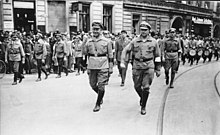Willy Leow

Willy Leow (born January 25, 1887 in Brandenburg an der Havel ; † October 3, 1937 in the Soviet Union ) was a German craftsman (carpenter) and politician of the Communist Party of Germany .
Live and act
Willy Leow attended elementary school in Brandenburg. He then learned the carpentry trade and was taught at the workers' training school in Berlin. In January 1904 Leow became a member of the German Association of Woodworkers . In the same year Leow joined the Social Democratic Party of Germany (SPD), of which he was a member until 1916. After Leow had already participated in the founding of the Spartakusbund in 1917 and briefly belonged to the Independent Social Democratic Party of Germany (USPD), he was a founding member of the Communist Party of Germany (KPD) at the end of 1918 .
In 1925, Leow was elected second chairman of the Red Front Fighters Association (RFB), the KPD's defense and protection organization founded in 1924. In 1928 Leow was elected to the Reichstag , to which he belonged until 1933. The SPD politician Herbert Wehner , who was himself a communist during the Weimar period, wrote decades later in his memoirs that Leow was “a thoroughly corrupt person”.
After the National Socialist " seizure of power ", Leow fled abroad. From 1935 he lived in the Soviet Union. He worked as an editor and head of the German-language state publisher in the Volga German Republic . In 1936 he was arrested in the course of the Stalinist purges and sentenced to death on October 3, 1937 for organizing a Trotskyist terrorist group before the military college of the Supreme Court of the USSR and shot .
post mortem
In the historiography of the German Democratic Republic , Leow fell victim to a so-called Damnatio memoriae for the first decades after his death, i.e. he was deliberately concealed in the history books of the GDR and in the public remembrance culture of the East German state: his person was deliberately not mentioned and traces of him Existence were systematically eliminated from document publications and image reproductions in the GDR. For example, Leow was retouched from a photograph that had been reprinted many times and showed him alongside Ernst Thälmann during an RFB parade in the 1920s. The reason for this practice was that the arrest and murder of Leow (i.e. a German communist and refugee from fascism) by the Soviet brother state did not fit into the history of the GDR and was therefore not allowed to appear in his publications.
literature
- Leow, Willy . In: Hermann Weber , Andreas Herbst : German Communists. Biographical Handbook 1918 to 1945 . 2nd, revised and greatly expanded edition. Karl Dietz, Berlin 2008, ISBN 978-3-320-02130-6 .
Web links
- Willy Leow in the database of members of the Reichstag
- Federal foundation to come to terms with the SED dictatorship : Biographical information from the Handbook of the German Communists. Retrieved December 8, 2019 .
Individual evidence
- ^ Herbert Wehner: witness , 1982, p. 79.
- ↑ Ulla Plener , Natalia Mussienko (ed.): Sentenced to the maximum penalty: death by shooting. Fatalities from Germany and German nationality in the Great Terror in the Soviet Union in 1937/1938 . Series: Texts / Rosa Luxemburg Foundation, Volume 27. Dietz, Berlin 2006, p. 58
- ↑ Walter Hütter: Pictures that lie. Book accompanying the exhibition of the House of History Foundation of the Federal Republic of Germany , Bonn 2000.
- ↑ welt.de: When pictures lie. Retrieved December 8, 2019 .
| personal data | |
|---|---|
| SURNAME | Leow, Willy |
| BRIEF DESCRIPTION | German craftsmen and politicians (KPD), MdR |
| DATE OF BIRTH | January 25, 1887 |
| PLACE OF BIRTH | Brandenburg on the Havel |
| DATE OF DEATH | October 3, 1937 |
| Place of death | Soviet Union |